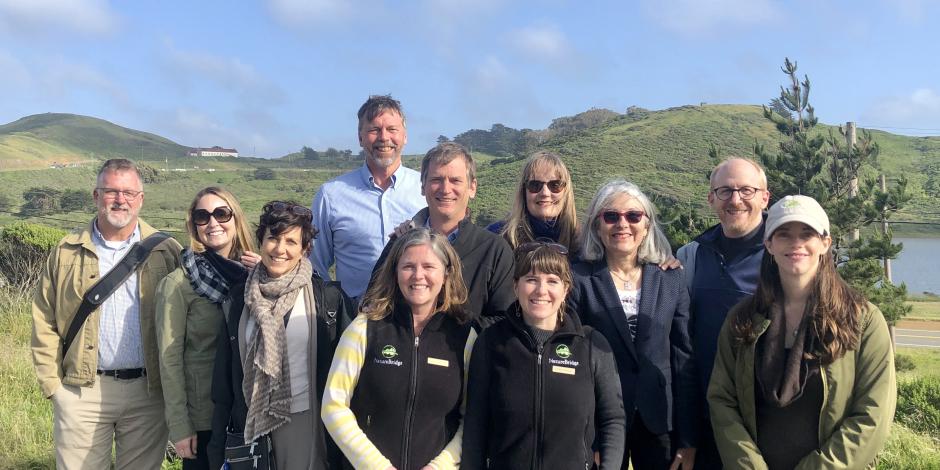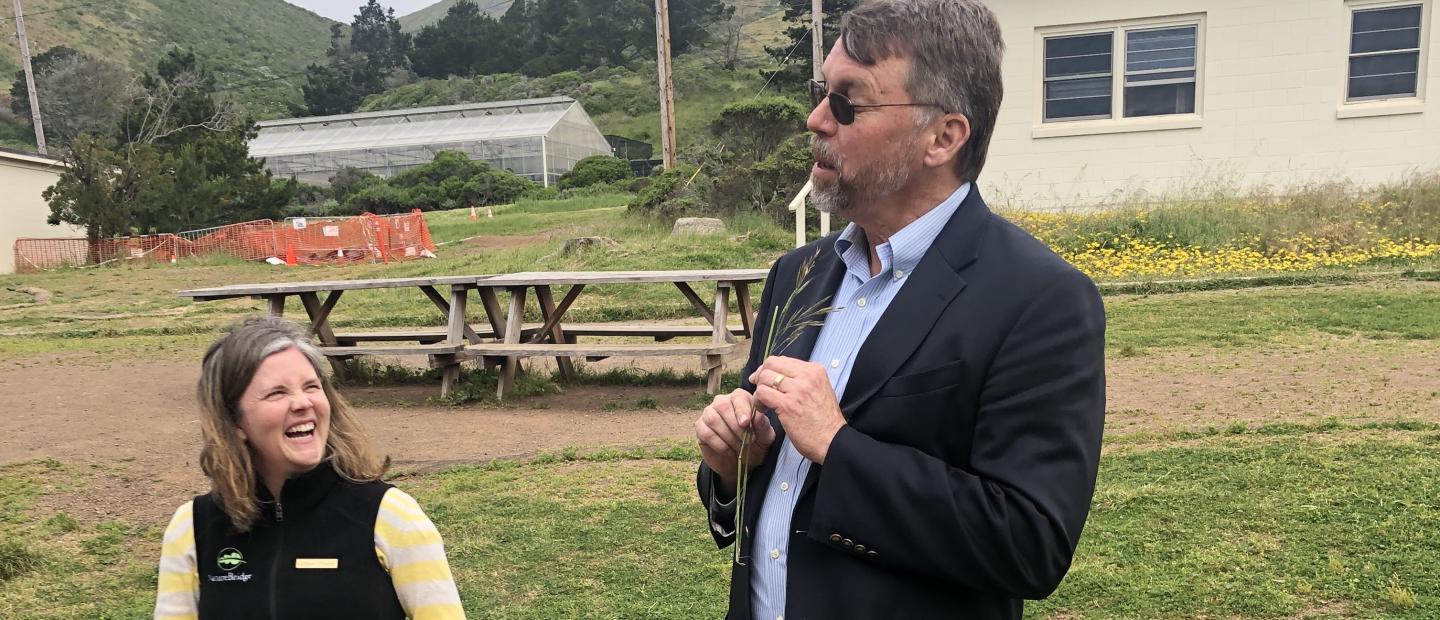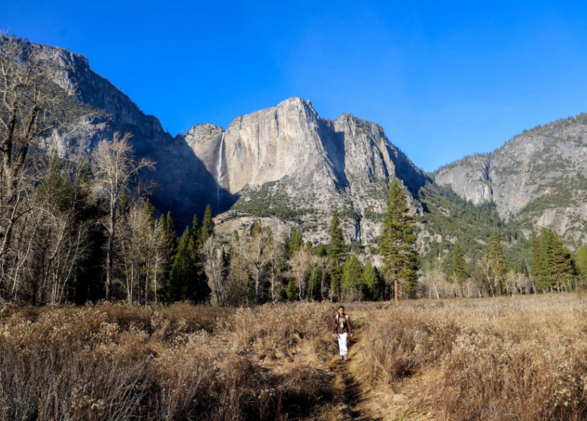Mapping the Future: NatureBridge’s Education Advisory Council

In our 50 Stories piece on social emotional learning (SEL), NatureBridge’s National Director of Education Meg Jakubowski talks about “the magic sauce” of environmental education, and how the organization has been utilizing grants and studies to better understand its own keen aptitude at SEL. But how does NatureBridge ensure that the “magic sauce” of SEL is in keeping with the latest research and data? How does NatureBridge create standardized yet individualized experiences across all campuses that have continued to produce incredible outcomes for its students?
“The Core Education Framework,” says Dr. Mary Kiely, a research biologist and founding member of NatureBridge’s Education Advisory Council (EAC).
The Core Education Framework (CEF) existed in a raw form at the behest of former NatureBridge President Garry Mitchell, who called on the Board of Directors education committee to standardize a programmatic curriculum across campuses. Board members Garry Brewer, Mel Marcus and Barry Bishop worked on creating NatureBridge’s first core curriculum framework in 1988.
In 1996, leadership envisioned a new CEF based on that extensive curriculum, crafted to provide guidance to the organization’s leadership, educators and other staff to align program policies, procedures and practices with the overall mission. Its three major themes: Interconnections, Sense of Place and Stewardship.
There were incremental, but substantial changes made to the CEF over the years, but it was not until 2009 that this version of the Framework underwent a major overhaul; an overhaul led by the newly formed EAC.
“At the request of the national board, we undertook a deep dive into the CEF,” says Mary, who was the NatureBridge Board of Directors’ Education Vice Chair at the time. “The year-long deep dive included the campus education directors (Yosemite, Olympic and Golden Gate) and the campus executive directors to ensure that the updated and revised CEF was an organization-wide effort, with reviews and suggestions incorporated from all campuses.”
Mary, along with Dr. Rich Shavelson (chair of the EAC at the time) and Dr. Nicole Ardoin (EAC member), traveled to all three campuses over the course of a year, gathering input.
“We were concurrently working with Rich’s and my teams at Stanford to augment the research and evaluation underpinnings,” says Nicole Ardoin, associate professor at the Graduate School of Education and senior fellow at the Woods Institute for the Environment at Stanford University, as well as the current chair of the EAC.
“In essence, the revised CEF updated content, provided examples of new ways to assess student learning and ways to improve teaching in the field with a more diverse group of students,” says Mary.
After another assessment nearly a decade later, the CEF grew and deepened with the explicit incorporation of SEL elements. It has become a living document through the research compiled by the EAC, and it remains foundational to the success of NatureBridge to this day.
I sat down with Mary Kiely and Nicole Ardoin to find out more about the EAC’s origins, the fascinating applications of their research and how the council’s work is putting NatureBridge on a national stage.

Where did the idea of having the Education Advisory Council (EAC) come from? Is this common practice for education nonprofits?
Mary Kiely: We created the EAC in 2008. There was a real impetus within the organization at that time to build a group of people that were experts in science, science education, education reform, learning sciences research, and, particularly, residential environmental field science. This group would help guide the education practices and respond to the board’s research questions.
Nicole Ardoin: As for common practice: it’s not necessarily common for an organization of NatureBridge’s size, but I would say that it’s an exciting trend in the field of environmental and outdoor education over the last 15 or so years. We’ve seen this trend toward organizations being increasingly interested in having research-practice connections. NatureBridge is really at the forefront of demonstrating that, and through going to conferences and co-presenting has helped show the organization's commitment to this connection.
The EAC’s research is often guided by questions you receive from the NatureBridge Board of Directors. Can you give some examples of questions they have raised in the past?
Mary: In the beginning, the board wanted to know the best practices in environmental field science and the issues that would be coming forth from the new National Science Education Standards (NSES) and how they might affect our programming. The NSES are one of the factors that can determine whether a school wants to attend a NatureBridge program, particularly for the teachers. They're under a tremendous amount of pressure because they have a curriculum from NSES that they need to get through. And so they have to see NatureBridge as a place in which the experiences on the campus for three to five days will enable them to move forward and integrate that into the curriculum they’re required to cover. It’s vitally important. The CEF examination also stemmed from the board.
Nicole, can you tell me a little about the Social Ecology Lab at Stanford and how it’s been connected to the EAC and NatureBridge?
Nicole: At Stanford I’m the founder and lead researcher in the Social Ecology Lab. Our lab includes more than a dozen doctoral students, visiting scholars, and research associates. Broadly, we research human-environment interactions, and we are interested in the ways in which environmental learning and connection to place motivate engagement and environmental behavior. We’re thinking not only about individual environmental behavior, but also collective action behaviors. Traditionally, in the environmental field, we've often thought about, “Do I turn off the lights when I leave a room? Do I choose a different mode of transportation to work?” But we increasingly see — with issues like climate change, biodiversity loss, invasive species, water scarcity and wildfire — that these are collective action issues. So while it's important that you and I make changes in our everyday-life practices, it's perhaps more important that we all do so as a community and on a collective scale.
And some of the most engaging and enjoyable work that the Social Ecology Lab has undertaken over the years has been in collaboration with NatureBridge. We've looked at different changes that may occur through NatureBridge programs. For example, we've done studies looking at how trust develops and builds over the course of a program and what kinds of networks develop among students who participate in NatureBridge experiences. We've looked specifically at elements of citizen science and the way that citizen-science participation develops youth’s sense of efficacy within the program as well as when they return home.
How do you make sure all of this research expands beyond the halls of academia? What are the real-world applications of some of these studies that you’ve done in the lab?
Nicole: We're definitely a theoretically driven group, but it's really important to us that our work is used in the world, as well. One of my favorite works is our study on trust, which we undertook in collaboration with NatureBridge. In that, we explored the role of trust when students are at NatureBridge and then when they return home, and how that influences their environmental literacy as well as readiness for follow-up actions. Often, when academics measure concepts like trust, these concepts come out of psychology and sometimes learning sciences, so the metrics we use are typically developed in a lab- or classroom-based setting. Here, we tried to step back and think about a concept like trust in a place like NatureBridge, where it can be quite different than in a psychology lab. In that kind of setting, you’re trying to shut out the outside world and minimize confounding variables. But in this study, we spent quite a bit of time going to the schools and talking with kids before they came to NatureBridge, and asking them, “what do you think it means for somebody to trust you? What do you think it means for you to trust someone else?” We used their own conceptions of trust to inform our measures. Then we used embedded approaches of following along with the students while they were at NatureBridge to better understand how the trust networks built over the course of the program.
So, why does this matter in the context of our work? We're trying to look at these environmental practices over time, and we described trust as an important antecedent to people being able to engage in their communities on difficult topics. So trust may not be a direct part of undertaking environmental behaviors, yet it's a critical ingredient when interacting in a community and taking action alongside others. It’s incredibly important to have trusting relationships with others when you need to address challenging topics where you may differ and yet still need to plan for the future. That was one reason we were really interested in studying how trust networks may shift at a place and through an experience like NatureBridge.
One of my favorite works is our study on trust, which we undertook in collaboration with NatureBridge. In that, we explored the role of trust when students are at NatureBridge and then when they return home, and how that influences their environmental literacy as well as readiness for follow-up actions.Nicole Ardoin
It’s easy to imagine the benefits to students when more research and data go into decision-making. It’s a conversation tangential to one we’ve had about social emotional learning with Director of Education Meg Jakubowski. But how has the work of the EAC been used or appreciated outside of NatureBridge? Is it broadly applicable in any way?
Mary: First, I want to say that the board has always been so receptive to the Education Advisory Council’s work, partially because they consider this a direct link to more of a national effort. One of the driving forces for NatureBridge as it’s matured in its fourth decade and now into its fifth is to have more of a national impact. There was a move about 10 years ago by the National Park Service to create a kind of residential education alliance, so that every organization in the country that works within the National Park System that does residential education would have representatives gather and share research. So all of a sudden, this little organization called NatureBridge was producing papers on a national level that talked about residential environmental science education and was also doing program evaluation that could be prescriptive and outline best practices not only for outdoor education, but perhaps in a formal school setting.
Nicole: We also have worked over the years to produce Environmental Education Research Bulletins, which we initially developed in collaboration with NatureBridge and that eventually transitioned into a partnership with NatureBridge and ChangeScale, and then the national environmental education training partnership, ee360. The bulletins are intended to take academic research and make it more accessible to environmental organizations like NatureBridge and others. What is great about the bulletins is that we were able to specifically picture a program on the ground at NatureBridge and think, “Okay, how is this article relevant to them? How would NatureBridge instructors be able to use this work?” We produced 14 bulletins over six years, and people all over the world read them. We still get people asking for and citing them, and they all have NatureBridge’s name on them. So, those bulletins were really a terrific and important contribution to the field from NatureBridge.
As you look to the next 50 years for NatureBridge, what do you envision for the EAC and the organization as a whole?
Nicole: I think, specifically, NatureBridge is well-positioned to be a leader in effective climate change education, whether that's place-based or whether that has a component that’s broader. You know, I'm constantly having conversations with people who ask about the best way to do effective climate change education, whether for youth, communities, or professionals, and I truly think that the jury's still out on that. I don't think there are any easy or straightforward solutions. That was something the EAC was thinking about two and a half years ago, in really innovative ways, before the pandemic, and I don't think that that's shifted a ton, even with COVID. We still have a group of very motivated, forward-looking people who are eager to make a change in the world. Our eyes are still on that faraway prize, always thinking about how we prepare for that future.
Mary: I think NatureBridge is poised to be stronger than ever. If it continues to engage Nicole and her group in academic research, it’s going to have even more of an impact. If anything, the pandemic showed us how much we miss being with people in person. I think the next 50 years can be even more important and impactful.

